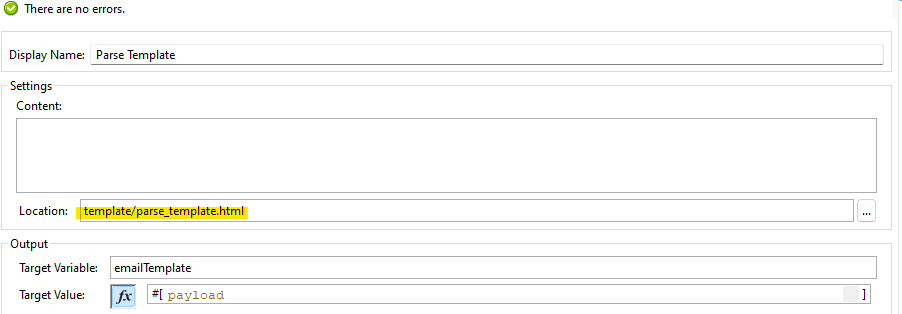Overview:
Parse Template in Mule 4 is a powerful feature that helps you create dynamic text by combining fixed content with variables and expressions. It’s handy for crafting well-formatted messages, emails, JSON responses, or HTML pages in your MuleSoft projects. With Parse Template, you get several advantages: it allows for dynamic content creation, has an easy-to-understand template format similar to common programming languages, seamlessly works with DataWeave for flexible data handling, and improves code readability by separating design from logic. Plus, it promotes code reuse and organization across your integration workflows, making development smoother. And, it’s optimized for speed, ensuring quick text generation without slowing down your Mule 4 applications. Overall, Parse Template empowers developers to efficiently generate dynamic content, enhancing the capabilities of MuleSoft applications for various use cases.
Connector description:
- Content:
This field represents the template string where you define the structure and content of the output you want to generate. It typically includes a combination of static text and dynamic expressions, allowing for flexible text generation. - Location:
This field specifies where the parsed output should be stored within the Mule message. It determines the context or scope in which the generated text will be available for further processing or transmission within the integration flow. - Target Variable:
The target variable indicates the variable within the Mule message where the parsed output will be assigned or stored. It provides a reference point for accessing the generated text in subsequent steps of the integration flow. - Target Value:
This field specifies the value or data that will be assigned to the target variable. It represents the result of parsing the template content and serves as the output of the Parse Template component.
Implementation:
- Step 1:
Set up a Mule 4 Project . Make sure you have a Mule 4 project ready in Anypoint Studio. If not, create a new project to start. - Step 2:
In Anypoint Studio, Navigate the “search palette” in the top right corner. Use it to find and add a Listener to your workspace and configure it, which listens for incoming data.
- Step 3:
Create a folder under src/main/resources and create a folder named template within this folder, create an HTML file according to your requirements.. Here we named it as “parse_template” with .html extension.

- Step 4:
The ‘parse_template.html’ consists of html code, which will serve as the template for sending emails.

- Step 5:
Search and drag the Parse Template connector into your message flow in Anypoint Studio. Configure the connector by providing the location of the HTML file containing the template, or directly input the template content.

- Step 6:
Then we are using SMTP connector and configure recipients, subject, and body for sending an alert email with the assistance of the parse template.

- Step 7:
The email will be sent in the expected format using the parse template, ensuring clear and consistent communication.

Conclusion:
In summary, Parse Template in Mule 4 simplifies dynamic content creation, making it easy to craft messages, emails, and more. With its user-friendly features and seamless integration, it enhances code readability and streamlines development. Incorporating Parse Template elevates efficiency and flexibility in MuleSoft projects, empowering developers to deliver robust solutions effortlessly.









